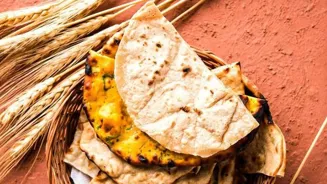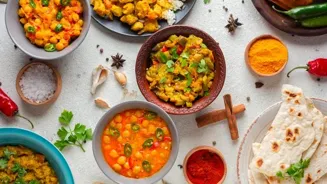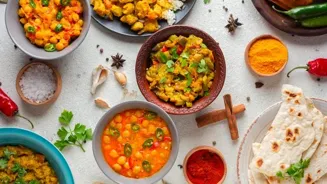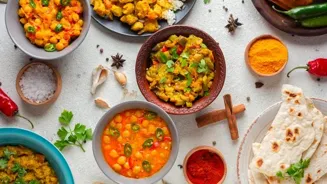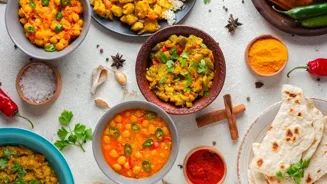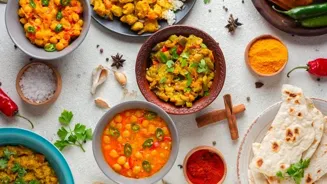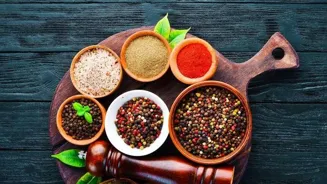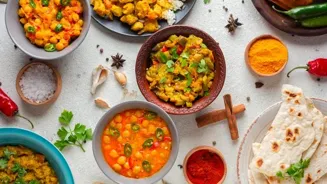Discover the vibrant world of Indian thalis - a symphony of flavors on one plate. Dive into the art of creating a balanced and fulfilling meal that represents the essence of Indian culinary traditions.
From the importance of each component to the regional variations that showcase diverse flavors, explore how a thali is not just a meal but a cultural experience. Delve deeper to unlock the secrets of crafting your own
The Indian thali, a symphony of flavors and textures presented on a single platter, is more than just a meal; it's a culinary journey. It represents the holistic approach to food in Indian culture, where balanced nutrition, taste, and visual appeal come together.
A well-composed thali provides all the essential nutrients required for a balanced diet. It typically includes carbohydrates, proteins, vitamins, and minerals in the right proportions.
The ingredients used are often seasonal and locally sourced, adding to the nutritional value and freshness of the meal. From the mountains of Kashmir to the shores of Kerala, every region boasts its own unique thali, reflecting the local ingredients and culinary traditions.
Crafting a vegetarian thali is a balanced art of diverse elements for a satisfying meal
Creating a vegetarian thali is an art form in itself, requiring careful consideration of various components to ensure a complete and satisfying meal. Daal (lentils) is a staple, offering a good source of protein and fiber.
Vegetable curries, prepared with a variety of seasonal vegetables, provide essential vitamins and minerals. Rice or roti (Indian bread) form the carbohydrate base, providing energy. Accompaniments like yogurt, chutney, and papad add flavor and complexity.
Sweet dishes round off the meal, providing a touch of indulgence. The goal is to offer a variety of flavors and textures that complement each other, making each bite an exciting experience.
Construct a balanced vegetarian thali with rice, daal, and diverse veggie dishes
To begin constructing your perfect vegetarian thali, start with the base: a good quality rice, like basmati, or freshly made rotis. Next, select your protein source. Daal is extremely important for providing protein of rich quality.
It can be prepared in a variety of ways, from simple daal tadka to creamy butter daal. Now, add two or three vegetable preparations. Consider seasonal vegetables and try to include a mix of preparations – a dry vegetable (sabzi), a gravy-based curry, and a vegetable with a sour note (like a kadhi).
Pay attention to colors also.
Accompaniments enhance thali experience with flavors and textures
Accompaniments elevate the entire thali experience. Yogurt or raita cools the palate and aids digestion. Chutneys, whether mint-coriander, mango, or tamarind, add a burst of flavor. Papad provides a crispy texture and adds a satisfying crunch.
A small portion of salad can add freshness and raw vitamins. Remember that while adding accompaniments, choose things that will aid with digestion for an overall nice experience. If you want, you can also add lemon for that tangy flavor.
A small bowl of pickle, though optional, can offer a spicy and tangy punch.
Balance is key in a thali for a flavorful and nutritious meal
Balance is crucial in a thali. The dish must be a harmonious spread of flavors. Include something sweet, something spicy, something savory, and something tangy. This will not only make the food tasty, but allow your tastebuds to have the best experience. It is important to balance the nutrients too.
A perfect thali contains a good proportion of carbohydrates, proteins and fats. Variety is the backbone of a great thali. Offer a change of colors and textures to keep the meal engaging. The way your thali looks also matters.
Thali: A cultural feast embodying Indian hospitality and cuisine
The thali is more than just a meal; it's a cultural experience. It embodies the Indian philosophy of 'Atithi Devo Bhava' – 'the guest is equivalent to God'. It's a gesture of warmth and abundance, showcasing the best of Indian cuisine.
Sharing a thali with loved ones is a way to connect and celebrate the joy of food. In a fast-paced world, the thali encourages mindful eating. Taking the time to savor each dish and appreciate the variety of flavors can be a truly rewarding experience.
It is a balanced food providing all necessary nutrients.
Indian thali celebrates rich culinary heritage in one plate
The Indian thali is a testament to the country’s rich culinary heritage. It offers a delightful and nutritious way to enjoy a complete meal on one plate.
With a little planning and creativity, anyone can create their own perfect vegetarian thali, a celebration of flavours, textures, and the spirit of Indian hospitality. So, next time you're looking for a satisfying and wholesome meal, embrace the art of thali and embark on a culinary adventure.
It could be your key to the best experience you have ever had while eating food.
Perfect vegetarian thali: balance dishes, presentation is key
The art of creating the perfect vegetarian thali isn't just about the dishes, it is also about presentation. The way the food is arranged on the platter can significantly enhance the dining experience. Start by strategically placing the bowls or katoris (small dishes) on the thali.
Larger bowls are usually reserved for daal and vegetable curries. You must make sure not to put too much food on the plate and over clog it. This is not only aesthetically unpleasing, but might also feel intimidating to others.
Arrange thali with care for visual appeal, elevate dining experience
The small containers or Katoris can be filled with your sides. Put different types of sweets and chutneys in these. Place the rice or roti strategically on the thali. Avoid overcrowding the thali. You can also add a small amount of butter next to the rice or roti.
Try to keep the presentation clean and aesthetically pleasing. Remove any spills or drips. It will be visually appealing and inviting. Your perfect presentation is a feast for the eyes and can elevate the entire dining experience.
With a bit of thought and care, you can arrange a visually pleasing and appetizing thali.
Thali etiquette: accompaniments enhance dining experience
Beyond taste and presentation, serving the thali with the right accompaniments and etiquette adds another layer of richness to the experience. Freshly squeezed lemon wedges, for instance, can be offered to brighten up the flavors of the dishes.
A glass of refreshing chaas (buttermilk), lassi (yogurt-based drink), or jaljeera (cumin-flavored water) can complement the meal and aid digestion. You should also offer water while the person eats.
